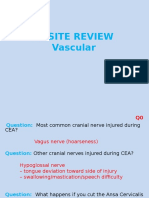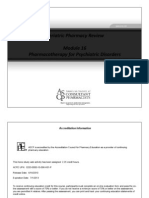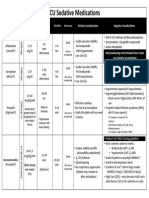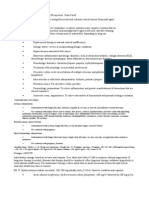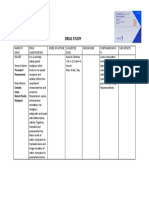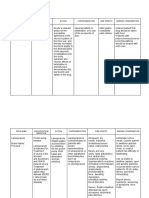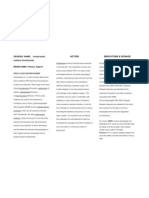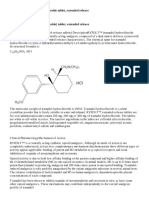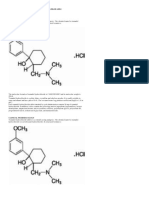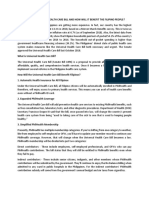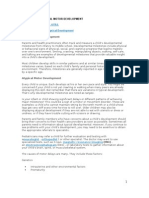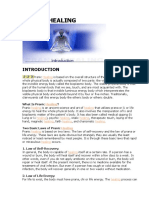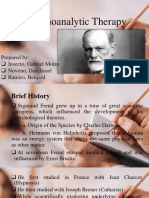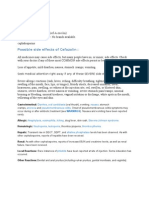Algesia
Algesia
Uploaded by
Saf DicamCopyright:
Available Formats
Algesia
Algesia
Uploaded by
Saf DicamOriginal Description:
Original Title
Copyright
Available Formats
Share this document
Did you find this document useful?
Is this content inappropriate?
Copyright:
Available Formats
Algesia
Algesia
Uploaded by
Saf DicamCopyright:
Available Formats
Tramadol hydrochloride + Paracetamol
AlgesiaTM
37.5 mg / 325 mg film-coated TABLET
ANALGESIC
FORMULATION
Each film-coated tablet contains:
Tramadol hydrochloride…………………….......…..……... 37.5 mg
Paracetamol………………………….......………………….. 325 mg
PRODUCT DESCRIPTION
Tramadol hydrochloride 37.5 mg + paracetamol 325 mg (Algesia)
Tablet is a blue, film-coated, biconvex, elliptical tablet, scored on
one side and plain on the other side
CLINICAL PHARMACOLOGY
Pharmacodynamics
Tramadol is a synthetic opioid analgesic. Its exact mechanism of
action is unknown but its analgesic effect appears to be produced
via the following mechanisms: (1) the affinity of M1, tramadol's
major metabolite, for the µ opioid receptor (2) the inhibition of the
reuptake of serotonin and noradrenaline.
Paracetamol has analgesic and antipyretic properties with weak
anti-inflammatory activity. The mechanism behind its therapeutic
effects has not been clearly explained although recent studies
propose that paracetamol inhibits the peroxidase portion of
cyclooxygenase, specifically targeting cyclooxygenase-3 (COX-3)
enzyme, which is mainly responsible for the synthesis of
prostaglandins in the brain cortex.
The tramadol + paracetamol combination presents an opportunity
to improve the spectrum of analgesic activity and reduce opioid
dosage. Studies have shown that tramadol given at subtherapeutic
doses (25% less than the recommended dose) together with
paracetamol at a fixed ratio of 1:9 can provide the same analgesic
effect produced by equianalgesic doses (50 mg) of tramadol alone.
The dose reduction markedly diminished the troublesome dose-
related adverse effects of tramadol (nausea, dizziness,
somnolence, constipation, and vomiting) and improved tolerability.
Pharmacokinetics
After a single oral dose of tramadol 37.5 mg + paracetamol 325 mg
combination tablet, peak plasma concentrations (Cmax) of both
tramadol enantiomers were 64.3 ng/mL [(+)-tramadol] and 55.5
ng/mL [(-)-tramadol]. These concentrations were achieved after
1.8 hours. Peak plasma concentration of paracetamol achieved
after 0.9 hour was 4.2 mcg/mL. The mean elimination half-lives (t1/2)
of both tramadol enantiomers were 5.1 hours [(+)-tramadol] and
4.7 hours [(-)-tramadol] and 2.5 hours for paracetamol.
Tramadol is well absorbed with mean absolute bioavailability of
approximately 75% after a single oral 100 mg dose. Peak
concentrations of tramadol and the M1 metabolite occur after 2 and
3 hours, respectively.
Paracetamol is rapidly and completely absorbed in the small
intestine via passive diffusion. Peak plasma concentrations are
achieved within 0.4 to 1 hour. A fatty meal may delay absorption but
does not affect extent of absorption.
Tramadol has high tissue affinity with a volume of distribution of 2.6
and 2.9 L/kg in male and female subjects, respectively, after oral
administration. Its affinity for plasma proteins is approximately 20%
and saturation occurs at doses beyond the therapeutic range.
Paracetamol is evenly distributed throughout most body fluids, but
not in fatty tissue. Volume of distribution is approximately 0.9 L/kg.
Its affinity for plasma proteins is low (approximately 10%-25%),
and practically does not displace other drugs which are highly
protein-bound.
Tramadol and its metabolites undergo extensive hepatic
metabolism via the CYP 2D6 and CYP 3A4 pathways and
conjugation of the parent drug and its metabolites. Most of the drug
is excreted in the urine as metabolites (approximately 60%) and the
remaining drug fraction is excreted in its unchanged form.
Paracetamol metabolism follows first-order kinetics, and primary
metabolic pathways involve conjugation with glucuronide and
sulfate and oxidation via the cytochrome P-450 mixed-function
oxidase pathway. In adults, most of the drug fraction is transformed
into the inactive glucuronide salt, and the remainder is conjugated
with sulfate.
Tramadol is cleared from the circulation via renal excretion. The
plasma elimination half-lives of racemic tramadol and M1 are
approximately 6 and 7 hours, respectively. The plasma elimination
half-life of racemic tramadol increased from approximately 7 to 9
hours upon multiple dosing of tramadol + paracetamol.
Paracetamol has a plasma elimination half-life that ranges from 2 to
3 hours in adults but this may be prolonged in patients with liver
disease. It is mainly excreted in the urine in its glucuronide or
sulfate form, and less than 9% is excreted unchanged.
INDICATION
• For the short-term (5 days or less) management of acute pain.
DOSAGE AND ADMINISTRATION
Tramadol + paracetamol can be administered with or without food
and is for oral use only.
Adults and children over 16 years old:
Orally, 1 to 2 tablets every 4 to 6 hours, as needed for pain relief, or,
as prescribed by a physician.
Maximum: 8 tablets per day.
Patients with a creatinine clearance of less than 30 mL/min:
It is recommended that the dosing interval of tramadol +
paracetamol be increased not to exceed 75 mg of tramadol and 650
mg of paracetamol (2 tablets) every 12 hours.
CONTRAINDICATIONS
• Hypersensitivity to tramadol, paracetamol, other opioids, or any
component of the product.
• In conditions where opioids are contraindicated, such as in
acute intoxication with the following substances: alcohol,
hypnotics, narcotics, centrally acting analgesics, opioids, or
psychotropic drugs, tramadol + paracetamol may worsen
Central Nervous System (CNS) and respiratory depression in
these patients.
WARNINGS AND PRECAUTIONS
Hepatotoxicity
Algesia contains tramadol hydrochloride and paracetamol.
Paracetamol has been associated with cases of acute liver
failure, at times resulting in liver transplant and death. Most
of the cases of liver injury are associated with the use of
paracetamol at doses that exceed 4,000 mg (4 g) per day, and
often involve more than one paracetamol-containing
product.
TRAMADOL:
Seizure Risk
Seizures have been reported in patients receiving tramadol
even within the recommended dose range. Seizure risk is
increased with tramadol doses above the recommended
range. Seizures can also occur after the first dose.
Concomitant use of tramadol increases seizure risk in
patients taking:
• Selective serotonin reuptake inhibitors (SSRI
antidepressants or anorectics)
• Tricyclic antidepressants (TCAs), and other tricyclic
compounds (e.g., cyclobenzapine, promethazine, etc.)
• MAO inhibitors
• Antipsychotics or neuroleptics (e.g., haloperidol,
droperidol, thioridazine)
• Other drugs that reduce seizure threshold
• Other opioids
Tramadol use may also increase the risk of convulsions in
patients with epilepsy, those with a history of seizures, or in
patients with a recognized risk for seizure (such as head
trauma, metabolic disorders, alcohol and drug withdrawal,
CNS infections). Administration of naloxone for tramadol
overdose may increase the risk of seizure.
Serotonin Syndrome Risk
Potentially life-threatening serotonin syndrome may occur
with the use of tramadol-containing products even within the
recommended dose. This may occur particularly with the
concomitant use of:
• Serotonergic drugs such as serotonin-norepinephrine
reuptake inhibitors (SNRIs), SSRIs, TCAs, MAOIs, and
triptans (e.g., sumatriptan, naratriptan, rizatriptan)
• Drugs that impair metabolism of serotonin (including
MAOIs)
• Drugs which impair metabolism of tramadol (CYP2D6 and
CYP3A4 inhibitors)
Serotonin syndrome may include mental-status changes (e.g.,
agitation, hallucinations, coma), autonomic instability (e.g.,
tachycardia, labile blood pressure, hyperthermia), neuromuscular
aberrations (e.g., hyperreflexia, incoordiation) and/or
gastrointestinal symptoms (e.g., nausea, vomiting, diarrhea).
Hypersensitivity/Anaphylaxis
Serious and rarely fatal anaphylactic reactions have been
reported in patients on tramadol therapy. These events occur
often following the first dose. Patients with a history of
anaphylactoid reactions to codeine or other opioids may be at an
increased risk and should therefore not receive tramadol +
paracetamol.
Alcohol and Drugs of Abuse
Tramadol may be expected to have additive effects when used
concomitantly with alcohol, other opioids or illicit drugs that cause
CNS depression.
Effects on Ability to Drive and Use Machines
Tramadol may impair mental or physical abilities required to
perform potentially hazardous tasks such as driving and operating
machinery.
PARACETAMOL:
Hepatotoxicity (see Boxed Warning)
The excessive intake of paracetamol may be intentional to
cause self-harm or unintentional as patients attempt to
obtain more pain relief or unknowingly take other
paracetamol-containing products.
The risk of acute liver failure is higher in persons with an
underlying liver disease and those who ingest alcohol while
taking paracetamol.
Patients should be instructed to look for paracetamol or
acetaminophen or APAP on package labels and not to use
more than one product that contains paracetamol. Medical
attention should be sought immediately upon ingestion of
more than 4,000 mg of paracetamol per day, even if they feel
well.
Use with other Paracetamol-Containing Products
Do not use concomitantly with other paracetamol-containing
products due to the potential for paracetamol hepatotoxicity at
doses higher than the recommended dose.
TRAMADOL + PARACETAMOL:
Suicide Risk
Do not prescribe tramadol + paracetamol to patients who are
suicidal or addiction prone. Prescribe tramadol +
paracetamol with caution in patients who are:
• Taking tranquilizers or antidepressant drugs
• Consuming excessive amounts of alcohol
• Suffering from emotional disturbance or depression
The cautious prescribing of tramadol is essential for the safe use
of this drug. Consideration should be given to the use of non-
narcotic analgesics for patients who are depressed or suicidal.
Tramadol-related deaths have occurred in patients with previous
histories of emotional disturbance or suicidal ideation, as well as
histories of misuse of tranquilizers, alcohol and other CNS-active
drugs.
Respiratory Depression
Tramadol + paracetamol should be administered cautiously in
patients at risk for respiratory depression. Respiratory depression
may result when tramadol is given in large doses with anesthetics
and alcohol. Consider alternative, non-opioid analgesics for these
patients.
Use with CNS Depressants
Exercise caution or reduce the dose when administering tramadol
+ paracetamol to patients receiving CNS depressants such as
alcohol, opioids, anesthetic agents, phenothiazines, tranquilizers
or sedative hypnotics because of increased risk of CNS and
respiratory depression.
Increased Intracranial Pressure or Head Trauma
Tramadol + paracetamol should be used with caution in patients
with increased intracranial pressure or head trauma. The
respiratory depressant effects of opioids include carbon dioxide
retention and secondary elevation of cerebrospinal fluid pressure
and may be markedly exaggerated in these patients.
MAO Inhibitors and SSRIs
Concomitant administration of tramadol + paracetamol with MAO
inhibitors and SSRIs may precipitate seizures and serotonin
syndrome.
Opioid-Dependent Patients
Tramadol + paracetamol should not be used in opioid-dependent
patients. Tramadol has been shown to reinitiate physical
dependence in some patients previously dependent on other
opioids.
Acute Abdominal Conditions
Tramadol + paracetamol may complicate the clinical assessment
of patients with acute abdominal conditions.
Liver Disease
The use of tramadol + paracetamol in patients with severe liver
impairment is not recommended.
Renal Disease
Tramadol + paracetamol has not been studied in patients with
impaired renal function.
Misuse, Abuse and Diversion
This medicine contains tramadol which can be sought by drug
abusers and people with addiction disorders. The possibility of
illegal or illicit use should be considered when prescribing or
dispensing tramadol + paracetamol in situations where the
physician or pharmacist is concerned about an increased risk of
misuse, abuse or diversion. Misuse or abuse of tramadol +
paracetamol poses a significant risk to the abuser which may
result in overdose and death.
The proper management of pain should not be prevented by
concerns about misuse, abuse and diversion. The development of
addiction to opioid analgesics in properly managed patients with
pain has been reported to be rare. However, data are not available
to establish the true incidence of addiction in chronic pain patients.
Risk of Overdosage
Patients should be warned not to exceed the dose recommended
by their physician. The use of tramadol in excessive doses, either
alone or in combination with other CNS depressants, including
alcohol, is a cause of drug-related deaths. Patients should be
cautioned about the concomitant use of tramadol and alcohol
because of the potentially serious CNS additive effects of these
agents. Due to its added depressant effects, tramadol should be
prescribed with caution in patients whose medical condition
requires concomitant administration of sedatives, tranquilizers,
muscle relaxants, antidepressants, or other CNS depressant
drugs.
Withdrawal
Abrupt discontinuation of tramadol + paracetamol may result in
withdrawal symptoms which may include: anxiety, diarrhea,
insomnia, nausea, pain, piloerection, rigors, sweating, tremors,
upper respiratory symptoms, and rarely, hallucinations. Other less
frequently observed symptoms include: panic attacks,
paresthesias and severe anxiety. Withdrawal symptoms may be
avoided by tapering the dose of the medicine at the time of
discontinuation.
DRUG INTERACTIONS
TRAMADOL
CONCOMITANT DRUGS EFFECTS
Additive effects may be expected when used
concomitantly with other opioids (e.g., fentanyl,
Drugs of Abuse pethidine), or illicit drugs that cause CNS
depression [e.g., gamma-hydroxybutyrate (GHB),
flunitrazepam]
Decreased analgesic effect due to increased
Carbamazepine metabolism of tramadol; risk of tramadol-associated
seizures. Concomitant use is not recommended
No clinically significant effect on tramadol’s
Cimetidine
pharmacokinetics
CYP3A4 inducers May decrease tramadol’s plasma concentration by
[e.g., rifampicin, St. John’s Wort inducing its hepatic metabolism by the isoenzyme
(Hypericum perforatum)] cytochrome P450-3A4
CYP2D6 inhibitors (e.g., amitriptyline,
May reduce metabolic clearance of tramadol, thus,
fluoxetine, paroxetine) and/or CYP3A4
increasing the risk for serious adverse events
inhibitors (e.g., ketoconazole,
including seizures and serotonin syndrome
erythromycin)
Digoxin Rare reports of digoxin toxicity
Increased plasma tramadol concentrations;
Quinidine
decreased plasma M1 concentrations
Serotonergic Drugs: α2-adrenergic
blockers (e.g., idazoxan, atipamezole);
MAO inhibitors (e.g., selegiline,
Increased risk o f serious adverse events including
phenelzine, linezolid); SSRIs
seizures and serotonin syndrome. Use with caution.
(e.g., fluoxetine, paroxetine); SNRIs
(e.g., venlafaxine, duloxetine) Triptans
(e.g., sumatriptan, naratriptan); Lithium
Rare alterations of warfarin effect including
Warfarin
elevation of prothrombin time; requires monitoring.
PARACETAMOL:
CONCOMITANT DRUGS EFFECTS
Increased conversion of paracetamol to
Anticonvulsants (e.g.,phenytoin, hepatotoxic metabolites; increased risk of
barbiturates, carbamazepine) hepatotoxicity
Aspirin No inhibition of antiplatelet effect of aspirin
Isoniazid Possible increased risk of hepatotoxicity
Phenothiazines Possible increased risk of severe
hypothermia
Additive effects may be expected when used
Alcohol Concomitantly with alcohol (e.g., ethanol);
Increased risk of paracetamol-induced
hepatotoxicity
Rare alterations of warfarin effect including
Warfarin elevation of prothrombin time; requires
monitoring.
STATEMENT ON USAGE FOR HIGH-RISK GROUPS
PREGNANCY AND LACTATION
Pregnancy
Pregnancy Category C. There are no adequate and well-
controlled studies in pregnant women. Tramadol + paracetamol
should be used during pregnancy only if the potential benefit clearly
outweighs the risks to the fetus. Chronic use during pregnancy may
lead to physical dependence and neonatal withdrawal symptoms.
Tramadol crosses the placenta. The mean ratio of serum tramadol
in the umbilical veins compared to maternal veins was 0.83 in 40
women given tramadol during labor. Postmarketing data on
tramadol HCl have reported neonatal seizures, neonatal withdrawal
syndrome, fetal death, and still births. The effect of tramadol +
paracetamol in the development of the child is unknown.
Lactation
The use of tramadol + paracetamol in breastfeeding mothers is not
recommended because its safety in infants and newborns has not
been studied.
USE IN CHILDREN
The safety and efficacy of tramadol + paracetamol in pediatric
patients has not been established.
USE IN THE ELDERLY
In general, dose selection for the elderly should be cautious,
reflecting the greater frequency of decreased hepatic, renal or
cardiac function. Dose selection should also reflect the greater
frequency of concomitant diseases and multiple drug therapy.
UNDESIRABLE EFFECTS
Body as a whole: asthenia, fatigue, hot flushes, chest pain, rigors,
syncope, withdrawal syndrome
Gastrointestinal: abdominal pain, constipation, diarrhea,
dyspepsia, flatulence, dry mouth, nausea, vomiting, dysphagia,
tongue edema, melena
Nervous System: dizziness, headache, tremor, ataxia,
convulsions, hypertonia, migraine, aggravated migraine,
involuntary muscle contractions, paresthesia, stupor, vertigo
Psychiatric: anorexia, anxiety, confusion, euphoria, insomnia,
nervousness, somnolence, amnesia, depersonalization,
depression, drug abuse, bad dreams, emotional lability,
hallucination, impotence, abnormal thinking, paroniria
Cardiovascular: aggravated hypertension, hypertension,
hypotension, arrhythmia, palpitation, tachycardia
Respiratory: dyspnea
Hepatic: abnormal hepatic function
Metabolic: decreased weight
Hematologic: anemia
Urinary: albuminuria, micturition disorder, oliguria, urinary retention
Dermatologic: pruritus, rash, increased sweating
Special Senses: tinnitus, abnormal vision
Adverse events previously reported with tramadol
hydrochloride: Vasodilation, myocardial ischemia, orthostatic
hypotension, allergic reactions (including anaphylaxis and urticaria,
Stevens-Johnson Syndrome/toxic epidermal necrolysis),
pulmonary edema, cognitive dysfunction, difficulty concentrating,
depression, suicidal tendency, hepatitis, liver failure, and
gastrointestinal bleeding.
Concomitant use of tramadol with other serotonergic agents such
as SSRIs and MAOIs has resulted in serotonin syndrome (mental
status change, hyperreflexia, fever, shivering, tremor, agitation,
diaphoresis, seizures, and coma).
Reported laboratory abnormalities include elevated creatinine and
liver function tests.
Adverse events previously reported with paracetamol: Allergic
reactions such as skin rash or hypersensitivity secondary to
paracetamol are rare. These are generally resolved by the
discontinuation of the drug.
DRUG ABUSE AND DEPENDENCE
Abuse
Tramadol has μ-opioid agonist activity. Tramadol +
paracetamol may be abused and may be subject to criminal
diversion.
Drug addiction is characterized by behaviors that include one or
more of the following: impaired control over drug use, compulsive
use, use for non-medical purposes, and continued use despite
harm or risk of harm, and craving. Drug addiction is a treatable
disease, utilizing a multidisciplinary approach, but relapse is
common.
Abuse and addiction are separate and distinct from physical
dependence and tolerance. Physicians should be aware that
addiction may not be accompanied by concurrent tolerance and
symptoms of physical dependence in all addicts. In addition, abuse
of tramadol + paracetamol can occur in the absence of true
addiction and is characterized by misuse for non-medical purposes,
often in combination with other psychoactive substances.
Proper assessment of the patient and periodic re-evaluation of
therapy are appropriate measures that help to limit the potential
abuse of this product.
Dependence
Opioid abstinence or withdrawal syndrome is characterized by
some or all of the following characteristics: restlessness,
lacrimation, rhinorrhea, yawning, perspiration, chills, myalgia, and
mydriasis. Other symptoms include irritability, anxiety, backache,
joint pain, weakness, abdominal cramps, insomnia, nausea,
anorexia, vomiting, diarrhea, or increased blood pressure,
respiratory rate, or heart rate.
Generally, tolerance and/or withdrawal are more likely to occur
the longer a patient is on continuous therapy with tramadol +
paracetamol.
OVERDOSAGE AND TREATMENT
The clinical presentation of overdose may include the signs and
symptoms of tramadol toxicity, paracetamol toxicity or both.
Tramadol overdosage and management:
Serious potential consequences of tramadol overdosage include
respiratory depression, seizures, somnolence progressing to
stupor or coma, skeletal muscle flaccidity, cold and clammy skin,
constricted pupils, seizures, bradycardia, hypotension, cardiac
arrest, and death.
Primary attention should be given in maintaining adequate
ventilation along with general supportive treatment. Naloxone
may reverse some, but not all symptoms caused by tramadol
overdosage. Administration of naloxone also increases the risk of
seizures. Hemodialysis is not expected to be helpful after
tramadol overdose because it removes less than 7% of the
administered dose in a 4-hour dialysis period.
Paracetamol overdosage and management:
Paracetamol in massive overdosage may cause hepatic toxicity
in some patients. In adults and children older than 12 years,
hepatic toxicity may occur after ingestion of greater than 7.5 to 10
g over a period of 8 hours or less. Fatalities are infrequent (less
than 3-4% of untreated cases) and have rarely been reported with
overdoses of less than 15 grams. In children less than 12 years
old, acute overdosage with paracetamol dose of less than 150
mg/kg body weight have not been associated with hepatic toxicity.
Early symptoms after a potentially hepatotoxic overdose may
include: nausea, vomiting, diaphoresis, and general malaise.
Clinical and laboratory evidence of hepatic toxicity may not be
apparent until 48 to 72 hours after paracetamol ingestion. In
adults and children over 12 years, any individual presenting with
an unknown amount of paracetamol ingested or with a
questionable or unreliable history about the time of ingestion
should have a plasma paracetamol level drawn and be treated
with N-acetylcysteine. Do not await results of assays for plasma
paracetamol levels before initiating treatment with N-
acetylcysteine. The following additional procedures are
recommended: prompt initiation of gastric decontamination,
plasma paracetamol assay (should be obtained as early as
possible, but no sooner than 4 hours after ingestion) and liver
function studies (should be obtained initially and repeated at 24-
hour intervals).
Serious toxicity or fatalities have been rare after acute
paracetamol overdose in young children, possibly because of
differences in the way they metabolize paracetamol. In children,
the maximum potential amount ingested can be more easily
estimated. If more than 150 mg/kg or an unknown amount of
paracetamol was ingested, obtain a plasma paracetamol level as
soon as possible, but no sooner than 4 hours following ingestion.
If an assay cannot be obtained and the estimated paracetamol
ingestion exceeds 150 mg/kg, dosing with N-acetylcysteine
should be initiated and continued for a full course of therapy.
STORAGE CONDITION
Keep the product out of reach and sight of children.
Store at temperatures not exceeding 30°C.
AVAILABILITY
Tramadol hydrochloride + Paracetamol (AlgesiaTM) 37.5/325mg
tablet in blister foil of 10’s box of 20’s and 50’s.
CAUTION: Foods, Drugs, Devices, and Cosmetics Act prohibits
dispensing without prescription.
Manufactured by Amherst Laboratories, Inc.
UNILAB Pharma Campus
Barangay Mamplasan
Biñan, Laguna, Philippines
for BIOMEDIS, INC.
6/F Dynavision Bldg., 108 Rada St.
Legaspi Village Date of Revision October 2011
Makati City, Philippines P30000005798
You might also like
- Janis Feshbach (1953)Document15 pagesJanis Feshbach (1953)ShaneLee102No ratings yet
- Absite Review VascularDocument183 pagesAbsite Review Vascularsgod34100% (1)
- Medicine Clinics Guide: Summary of Bates Tables From DR DominguezDocument226 pagesMedicine Clinics Guide: Summary of Bates Tables From DR DominguezSaf DicamNo ratings yet
- FINALLY!!! A Scientific Breakthrough We Have Been Looking Forward To...Document10 pagesFINALLY!!! A Scientific Breakthrough We Have Been Looking Forward To...Robinxjehp0% (1)
- Module 16 - Pharmacotherapy For Psychiatric DisordersDocument157 pagesModule 16 - Pharmacotherapy For Psychiatric Disordersgeekay79No ratings yet
- Sedation in IcuDocument2 pagesSedation in Icumathurarun2000No ratings yet
- ChildrensHypnosisScripts IndexDocument1 pageChildrensHypnosisScripts IndexRaphaela Alencar0% (1)
- P 398Document1 pageP 398Arup Ratan PaulNo ratings yet
- College of Nursing: Cebu Normal UniversityDocument3 pagesCollege of Nursing: Cebu Normal UniversityShiva TorinsNo ratings yet
- Hydrocortisone Inj. (IV)Document2 pagesHydrocortisone Inj. (IV)zepoli_zepoly6232No ratings yet
- Name Mucosta Tablets 100 Description PDFDocument7 pagesName Mucosta Tablets 100 Description PDFnanda RaharjaNo ratings yet
- New DS3Document3 pagesNew DS3dakieNo ratings yet
- TRAMADOLDocument4 pagesTRAMADOLRudie Lee PascualNo ratings yet
- Availability: Classifications: Antiinfective Antitrichomonal Amebicide Antibiotic Pregnancy Category: BDocument5 pagesAvailability: Classifications: Antiinfective Antitrichomonal Amebicide Antibiotic Pregnancy Category: BCay SevillaNo ratings yet
- Doxofylline: D 400 MG TabletsDocument33 pagesDoxofylline: D 400 MG TabletsBibek Singh Mahat100% (2)
- Xarelto PDFDocument33 pagesXarelto PDFNovita Dewi LestariNo ratings yet
- Drug Study-Liver CirrhosisDocument10 pagesDrug Study-Liver Cirrhosischelsea_ishk12No ratings yet
- Apixaban 5 PDFDocument2 pagesApixaban 5 PDFWanie Al-basriNo ratings yet
- Drug StudyDocument5 pagesDrug Studyjanelle123 toribioNo ratings yet
- Paracetamol (Alvedon) Acetylcysteine Fluimucil KCL (Kalium Durule)Document1 pageParacetamol (Alvedon) Acetylcysteine Fluimucil KCL (Kalium Durule)Jesse James Advincula EdjecNo ratings yet
- F&E Drug StudyDocument2 pagesF&E Drug Studychelle_asenjoNo ratings yet
- Rocuronium: Bromide InjectionDocument2 pagesRocuronium: Bromide InjectionNursalfarinah BasirNo ratings yet
- Drug AnalysisDocument3 pagesDrug AnalysisAnn Aquino100% (1)
- CombiventDocument1 pageCombiventDherick Rosas0% (1)
- DRUG StudyDocument6 pagesDRUG StudyJheryck SabadaoNo ratings yet
- Sal But AmolDocument2 pagesSal But AmolCalimlim KimNo ratings yet
- TramadolDocument1 pageTramadolAi RouNo ratings yet
- Transmetil 500mgDocument6 pagesTransmetil 500mgHarisankarthekkethil 26No ratings yet
- Drug Study 2Document8 pagesDrug Study 2rey_tengNo ratings yet
- Drug Study - HYDROCORTISONE, DIAZEPAM, DIGOXIN EtcDocument6 pagesDrug Study - HYDROCORTISONE, DIAZEPAM, DIGOXIN Etc'jmark FranciaNo ratings yet
- Drug StudyDocument10 pagesDrug Studyjho_26100% (2)
- CoversylDocument3 pagesCoversylianecunarNo ratings yet
- Calcium 600/vitamin DDocument3 pagesCalcium 600/vitamin DE100% (1)
- Disturbed Sleeping Pattern NCPDocument4 pagesDisturbed Sleeping Pattern NCPSamVelascoNo ratings yet
- SimvastatinDocument1 pageSimvastatinLyka Mae Imbat - PacnisNo ratings yet
- Drug Study - CholangioDocument10 pagesDrug Study - CholangioClaireMutiaNo ratings yet
- NafarinDocument2 pagesNafarinianecunar100% (2)
- Agn NCPDocument6 pagesAgn NCPJewel AnneNo ratings yet
- KaliumDocument2 pagesKaliumJustine Kaye Iballa HarligaNo ratings yet
- NCM 104 (DUTY) - Risperidone Drug StudyDocument1 pageNCM 104 (DUTY) - Risperidone Drug StudyArthur Christopher CorpuzNo ratings yet
- Salazar DsDocument4 pagesSalazar DsDjayNo ratings yet
- As Pi LetDocument7 pagesAs Pi Letianecunar100% (1)
- Drug StudyDocument2 pagesDrug Studydwyane0033No ratings yet
- Para Iterax XylogelDocument2 pagesPara Iterax XylogelArchie PunzalanNo ratings yet
- Assessment Diagnosis Planning Intervention Rationale EvaluationDocument4 pagesAssessment Diagnosis Planning Intervention Rationale EvaluationJhoizel VenusNo ratings yet
- Drug Study Ko ToDocument4 pagesDrug Study Ko ToGian Carlo FernandezNo ratings yet
- Dolcet Drug StudyDocument1 pageDolcet Drug StudyJianne CaloNo ratings yet
- Drug Study (MS)Document9 pagesDrug Study (MS)Kristine GallardoNo ratings yet
- Myonal, LevoprontDocument1 pageMyonal, LevoprontMarieCrisNo ratings yet
- Drug Study PantoprazoleDocument3 pagesDrug Study PantoprazoleIRISH CACAYANNo ratings yet
- Primaxin (Imipenem - Cilistatin)Document2 pagesPrimaxin (Imipenem - Cilistatin)ENo ratings yet
- Generic Name: Brand Name: Pletal: Pharmacologic Class: Pharmacokinetics General Indications Contraindications BeforeDocument2 pagesGeneric Name: Brand Name: Pletal: Pharmacologic Class: Pharmacokinetics General Indications Contraindications Beforeart_mutantNo ratings yet
- Mu CostaDocument6 pagesMu Costafarracholidia_867630No ratings yet
- Drug StudyDocument7 pagesDrug StudyMelody Forca FranciscoNo ratings yet
- Omeprazole - Drug StudyDocument2 pagesOmeprazole - Drug StudyJun Gilbuena100% (1)
- AlgesiaDocument2 pagesAlgesiaNanen Camince100% (1)
- The Ride of Your Life: What I Learned about God, Love, and Adventure by Teaching My Son to Ride a BikeFrom EverandThe Ride of Your Life: What I Learned about God, Love, and Adventure by Teaching My Son to Ride a BikeRating: 4.5 out of 5 stars4.5/5 (2)
- Algesia: 37.5 MG / 325 MG Film-Coated TABLET AnalgesicDocument1 pageAlgesia: 37.5 MG / 325 MG Film-Coated TABLET AnalgesicEsel WazowskiNo ratings yet
- Tramadol Hydrochloride + Paracetamol: 37.5 MG / 325 MG Film-Coated TABLET Analgesic ™algesiaDocument7 pagesTramadol Hydrochloride + Paracetamol: 37.5 MG / 325 MG Film-Coated TABLET Analgesic ™algesiaNikkae AngobNo ratings yet
- TRADMIN 50 Tramadol Caspules SmPCDocument10 pagesTRADMIN 50 Tramadol Caspules SmPClydiakawaggaNo ratings yet
- RYZOLT - Tramadol Hydrochloride Tablet, Extended Releas e Stat RX USADocument20 pagesRYZOLT - Tramadol Hydrochloride Tablet, Extended Releas e Stat RX USApuloh8289No ratings yet
- S 039 LBLDocument45 pagesS 039 LBLAstha BhalodiaNo ratings yet
- TRAMADOL HYDROCHLORIDE - Tramadol Hydrochloride Tablet Remedyrepack IncDocument11 pagesTRAMADOL HYDROCHLORIDE - Tramadol Hydrochloride Tablet Remedyrepack IncBhargav BikkaniNo ratings yet
- TramadolDocument5 pagesTramadolRaluca Elena Raluca ElenaNo ratings yet
- Contramal (Tramadol) : Uses, Side Effects, DosageDocument4 pagesContramal (Tramadol) : Uses, Side Effects, DosageRaluca Elena Raluca ElenaNo ratings yet
- Motilium PIDocument12 pagesMotilium PIKok Foo YipNo ratings yet
- Tramadol Hydrochloride/paracetamol 37.5 mg/325 MG Film-Coated TabletsDocument2 pagesTramadol Hydrochloride/paracetamol 37.5 mg/325 MG Film-Coated Tabletspbalakrishnan100% (1)
- VaginitisDocument37 pagesVaginitisSaf DicamNo ratings yet
- Case 14 Q4Document1 pageCase 14 Q4Saf DicamNo ratings yet
- Your Big IdeaDocument21 pagesYour Big IdeaSaf DicamNo ratings yet
- What Is Universal Health Care Bill and How Will It Benefit The Filipino PeopleDocument2 pagesWhat Is Universal Health Care Bill and How Will It Benefit The Filipino PeopleSaf DicamNo ratings yet
- In Brief: Inguinal HerniaDocument4 pagesIn Brief: Inguinal HerniaSaf DicamNo ratings yet
- Gustilo Classification PDFDocument1 pageGustilo Classification PDFSaf DicamNo ratings yet
- Filipino (Judging Sheet)Document4 pagesFilipino (Judging Sheet)Saf DicamNo ratings yet
- MC 2014-009 Crime Incident Recording SystemDocument12 pagesMC 2014-009 Crime Incident Recording SystemSaf Dicam100% (1)
- MC 2014-016 E-Subpoena SystemDocument20 pagesMC 2014-016 E-Subpoena SystemSaf DicamNo ratings yet
- DOH Hospitals DirectoryDocument31 pagesDOH Hospitals DirectorySaf DicamNo ratings yet
- Worded ProblemDocument3 pagesWorded ProblemSaf DicamNo ratings yet
- Final ThesisDocument37 pagesFinal ThesisSaf DicamNo ratings yet
- Family Nursing Care PlanDocument2 pagesFamily Nursing Care PlanSaf DicamNo ratings yet
- PDF A Guide To Starting Your Own Complementary Therapy Practice 1st Edition Elaine Mary Aldred BSC (Hons) DC Licac Dip Herb Med Dip CHM DownloadDocument84 pagesPDF A Guide To Starting Your Own Complementary Therapy Practice 1st Edition Elaine Mary Aldred BSC (Hons) DC Licac Dip Herb Med Dip CHM Downloadherbisshane100% (13)
- Art Therapy With Orphaned Children: Dynamics of Early Relational Trauma and Repetition CompulsionDocument11 pagesArt Therapy With Orphaned Children: Dynamics of Early Relational Trauma and Repetition CompulsionGabriella SalzNo ratings yet
- Pathophysiology of HFDocument40 pagesPathophysiology of HFHayaNo ratings yet
- QMC HR Review 2022Document9 pagesQMC HR Review 2022Kristin VillasenotNo ratings yet
- Smilesujokppt 160424204858Document79 pagesSmilesujokppt 160424204858Sonali Bhosle-Ghatnekar91% (11)
- Adjunctive Deep Touch Pressure For Comorbid Anxiety in Bipolar Disorder Mediated by Control of Sensory InputDocument7 pagesAdjunctive Deep Touch Pressure For Comorbid Anxiety in Bipolar Disorder Mediated by Control of Sensory Inputariq imamNo ratings yet
- Dr. Nadeem (Physiotherapy) - 2Document2 pagesDr. Nadeem (Physiotherapy) - 2faeeq1200No ratings yet
- Lupin Ar2011 Ebook 1Document91 pagesLupin Ar2011 Ebook 1RavishankarNo ratings yet
- PsychopharmacologyDocument50 pagesPsychopharmacologyapi-3703352No ratings yet
- SOP On OTZDocument5 pagesSOP On OTZSemeeeJuniorNo ratings yet
- Typical and Atypical Motor DevelopmentDocument2 pagesTypical and Atypical Motor DevelopmentVirnabe PeliasNo ratings yet
- Osteoarthritis: BY: Agudon, Cyril Joyce Nobleza, FriahDocument18 pagesOsteoarthritis: BY: Agudon, Cyril Joyce Nobleza, FriahTrixie Marie Sabile AbdullaNo ratings yet
- SDP 2 Goal SettingDocument20 pagesSDP 2 Goal SettingJacobNo ratings yet
- Stress &healthDocument18 pagesStress &healthsatmayaniNo ratings yet
- TB1 Chapter 15 - Multiple ChoiceDocument36 pagesTB1 Chapter 15 - Multiple ChoiceMonicaNo ratings yet
- Pranic HealingDocument73 pagesPranic HealingShah Alam75% (4)
- Overview of Nephrotic SyndromeDocument19 pagesOverview of Nephrotic Syndromefarmasi_hm100% (1)
- 1941 - Otto Fenichel - The Ego and The AffectsDocument8 pages1941 - Otto Fenichel - The Ego and The AffectsFernando Ferrari100% (1)
- Metacognition MBCTDocument13 pagesMetacognition MBCTIván FritzlerNo ratings yet
- Chandru JudgementDocument47 pagesChandru Judgementapi-43235306No ratings yet
- Psychoanalytic TherapyDocument17 pagesPsychoanalytic Therapyshiek mohametano100% (1)
- PM Exam Sample QuestionsDocument12 pagesPM Exam Sample QuestionsDexter LimNo ratings yet
- NCPDocument18 pagesNCPChristian Karl B. LlanesNo ratings yet
- Cefazolin: Possible Side Effects of CefazolinDocument3 pagesCefazolin: Possible Side Effects of CefazolinConn_Casipe_8158No ratings yet

